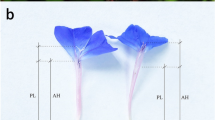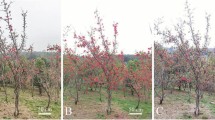Abstract
Tuberose [Agave amica (Medik.) Thiede & Govaerts] is a tropical bulb grown commercially for its sweet-scented flowers and highly valued essential oil. In this study, the floral morphologies of 18 tuberose genotypes were studied to understand their diversity and compatibility (for selfing and crossing) so that prerequisites for parental selection can be established. The genotypes—all of which had single florets—varied significantly in terms of floret length, floret diameter, tepal thickness, number of tepals, and stamen length. The flowers opened in the evening, and anther dehiscence occurred within 20–30 min of anthesis. The styles showed three distinct morphological types in terms of the relative positions of the stigma and the upper or lower ends of the stamen, as follows: L-morph, for long styles, if the stigma was located above the upper end of the stamen; S-morph, for short styles, if the stigma was below the lower end of the stamen; and I-morph, for style of intermediate length, if the stigma was positioned somewhere in between the upper and lower ends of the stamen. Stigma receptivity increased gradually, whereas pollen viability declined slowly from the 1st to the 4th day of anthesis. Self-compatibility, self-incompatibility, and sterility were confirmed via autogamy, geitonogamy, and controlled pollination. In ‘Arka Prajwal’, the pollen tube entered the ovule 24 h after pollination and the female gametophyte developed up to 5 days after pollination. However, the embryo sac began to degenerate from the 7th day of pollination and the pods were shed, which confirmed the sterility of the ovule. This comprehensive study of floral morphology is expected to provide useful insights for breeding tuberoses of superior flower quality and improved yield of the essential oil.







Similar content being viewed by others
References
Anonymous (2022). https://www.imarcgroup.com/india-essential-oil-market-impelled-rising. Accesses on 28 Nov 2023
Anonymous (2023). Fragrance and flavour industry in india. MSME, Government of India. https://msme.gov.in/fragrance-flavour-industry-india. Accessed on 27 Oct 2023
Antkowiak W, Niemann J, Wojciechowski A (2017) The assessment of incompatibility and cross-compatibility in three populations of European globeflower (Trollius europaeus L.) by observing the pollen tubes growth. Acta Soc Bot Pol 86(2):3553. https://doi.org/10.5586/asbp.3553
Arroyo MB, Barrett SCH (2000) Discovery of distyly in Narcissus (Amaryllidaceae). Am J Bot 87:748–751
Bailey LH (1919) The standard cyclopedia of horticulture, vol 2. Macmillan, New York. https://doi.org/10.1038/101241a0
Barrett SCH, Jesson LK, Baker AM (2000) The evolution and function of stylar polymorphisms in flowering plants. Ann Bot 85:253–265. https://doi.org/10.1006/anbo.1999.1067
Barrett SCH, Lloyd DG, Arroyo J (1996) Stylar polymorphisms and the evolution of heterostyly in Narcissus (Amaryllidaceae). Floral Biol. Studies on Floral. Evolution in Animal-Pollinated Plants, pp 339–376
Brewbaker JL, Kwack BH (1963) The essential role of calcium ion in pollen germination and pollen tube growth. Am J Bot 9:859–865. https://doi.org/10.1002/j.1537-2197.1963.tb06564.x
Choi CPA, Wiersma PT, Kappel F (2002) Fruit growth, firmness and cell wall hydrolytic enzyme activity during development of sweet cherry fruit treated with gibberellic acid (GA3). J Hort Sci Biotechnol 77(5):615–621. https://doi.org/10.1080/14620316.2002.11511547
Cruden RW (2000) Pollen grains: why so many? Plant Syst Evol 222:143–165
Fonseca RS, Santos FAD, Vieira MF (2015) Is the pollination efficiency of long-lived orchid flowers affected by age. Revista Cere 62:347–350
Gandhi DP, Bharathi TU (2021) Genetic variability and diversity study in tuberose (Polianthes tuberosa L.). Int J Chem Stud 9(3):235–340
Gutiérrez AGG, Garay BR (2016) Embryogenesis in Polianthes tuberosa L. var. simple: from megasporogenesis to early embryo development. Springer plus 25(1):1–13. https://doi.org/10.1186/s40064-016-3528-z
He G, Hu F, Ming J, Yuan S (2017) Pollen viability and stigma receptivity in Lilium during anthesis. Euphytica 213:231
Hemanta L, Srivastava R, Kumar A, Chand S (2016) Studies on Seed Set by open Pollination in tuberose (Polianthes tuberosa L.) under Tarai Regions of Uttarakhand. J Agri Technol 3(1):71
Hemanta L (2015). Studies on floral biology, pollination and crossability in tuberose (Polianthes tuberosa L.). Ph.d. thesis, GB PUAT, Pantnagar, India
Herrero M, Dickinson HG (1981) Pollen tube development in Petunia hybrida following compatible and incompatible intraspecific matings. J Cell Sci 47:365–383. https://doi.org/10.1242/jcs.47.1.365
Jacquemart AL, Somme L, Colin C, Quinet M (2015) Floral biology and breeding system of Impatiens balfourii (Balsaminaceae): an exotic species in extension in temperate areas. Flora-Morphol Distrib Func Ecol Plants 214:70–75
Jensen WA (1962) Botanical histochemistry-principles and practice. Freeman, William and Jensen, San Francisco, p 408
Joshi AC, Pantulu JV (1940) A morphological and cytological study of Polianthes tuberosa L. J Ind Bot Soc 20:37–71
Kakani VG, Reddy KR, Koti S, Wallace TP, Prasad PVV, Reddy VR, Zhao D (2005) Differences in in vitro pollen germination and pollen tube growth of cotton cultivars in response to high temperature. Ann Bot 96(1):59–67. https://doi.org/10.1093/aob/mci149
Karihaloo JL (2019) Cytological and hybridization studies in three cultivars of tuberose (Polianthes tuberosa L.). Cytologia 84(1):47–52. https://doi.org/10.1508/cytologia.84.47
Kishore K, Samant D, Singh HS, Behera S (2017) Studies on reproductive strategies of sapota (Manilkara Zapota). J Environ Biol 38:361–366
Krishnamoorthy V (2014) Assessment of tuberose (Polianthes tuberosa L.) varieties for growth and yield characters. As J Hort 29(2):515–517. https://doi.org/10.15740/HAS/TAJH/9.2/515-517
Krishnamurthy KB, Srinivas M (2005) Histological and histochemical studies of ovule development in tuberose (Polianthes tuberosa L.). J Orn Hort 8(2):81–85
Liang CL, Liu MJ, Zhao J (2005) Research progress on plant abortion. Mol Plant Breed 3(1):117–122
Ranchana P (2013) Evaluation of tuberose genotypes for development of F1 hybrids for quantitative, qualitative characters and nematode resistance. Ph.d. thesis, TNAU, Coimbatore, India
Ranchana P, Kannan M (2015) Studies on floral biology of tuberose (Polianthes tuberosa L.). Trends Biosci 8:1435–1438
Ranchana P, Kannan M (2016) Self and cross compatibility studies in tuberose (Polianthes tuberosa L.). The Bioscan 11(1):33–36
Regen L (1941) The development of the embryo sac in Agave virginica. In: Bulletin of the Torrey Botanical Club, pp 229–236. https://doi.org/10.2307/2481501
Sadhu MK, Bose TK (1973) Tuberose for most artistic garlands. Ind Hort 18:17–20
Sage TL, Strumas F, Cole WW, Barrett SCH (1999) Differential ovule development following self-and cross-pollination: the basis of self-sterility in Narcissus triandrus (Amaryllidaceae). Am J Bot 86(6):855–870. https://doi.org/10.2307/2656706
SAS (Statistical Analysis System) (2011) SAS Version 9.3. Procedure Guide. SAS Inc., Cary
Seetharamu GK (1993) Hybridization studies in tuberose (Polianthes tuberosa Linn.). Ph.d diss., UAS, Bangalore
Shao F, Wang S, Liu Z, Hong R, Zhao T (2020) Pollination, fertilization and embryo development in southern China Fresh eating Jujube. Hort Sci 55(8):1315–1322. https://doi.org/10.21273/HORTSCI15144-20
Srivastava HC, Sridhara CJ (1999) Studies of floral biology of tuberose (Polianthes tuberosa). J Med Aromat Plant Sci 21:934–936
Stanley RG, Linskens HF (1974) Viability tests. Pollen. Springer, Berlin, Heidelberg, pp 67–86. https://doi.org/10.1007/978-3-642-65905-8_6
Sulusoglu M, Cavusolglu A (2014) In Vitro pollen viability and pollen germination in Cherry Laurel (Prunus laurocerasus L.). Sci World J. https://doi.org/10.1155/2014/657123
Uma S (1990) Studies on causes of non-seed setting in some ornamental bulbous crops. Ph.d. Thesis, UAS, Bangalore, India
Uma S, Gowda JVN (2000) Self-incompatibility studies in Polianthes tuberosa L. Res Crops 1(3):418–420
Williams EG, Knox BR, Rouse JL (1982) Pollination sub-systems distinguished by pollen tube arrest after incompatible interspecific crosses in Rhododendron (Ericaceae). J Cell Sci 53:255–277. https://doi.org/10.1242/jcs.53.1.255
Yan MR, Wang CH, Jose Cruz Flores N, Su YY (2019) Targeting open market with strategic business innovations: A case study of growth dynamics in essential oil and aromatherapy industry. J Open Innov Technol Mark Complex 5(1):7. https://doi.org/10.3390/joitmc5010007
Zeisler M (1933) Über die Abgrenzung des eigentlichen Narben fläche mit Hilfe von Reaktionen Beitr Bot 55 Zentl.A58: 308–318
Acknowledgements
The authors are thankful to Science Engineering and Research Board, New Delhi and ICAR–Indian Institute of Horticulture Research, Bangalore for providing support.
Funding
Science Engineering and Research Board, New Delhi.
Author information
Authors and Affiliations
Contributions
TUB conceived and designed the study and acquired funding, TUB, RL and SPK conducted the experiments, collected data, performed statistical analysis, interpreted the results and wrote the paper.
Corresponding author
Ethics declarations
Conflict of interest
The author(s) declare(s) that they have no competing interests.
Additional information
Publisher's Note
Springer Nature remains neutral with regard to jurisdictional claims in published maps and institutional affiliations.
Rights and permissions
Springer Nature or its licensor (e.g. a society or other partner) holds exclusive rights to this article under a publishing agreement with the author(s) or other rightsholder(s); author self-archiving of the accepted manuscript version of this article is solely governed by the terms of such publishing agreement and applicable law.
About this article
Cite this article
Bharathi, T.U., Lallawmzuali, R. & Kirthishree, S.P. Diversity in flower morphology of the single-type tuberose (Agave amica (Medik.) Thiede & Govaerts). Genet Resour Crop Evol (2024). https://doi.org/10.1007/s10722-024-01906-7
Received:
Accepted:
Published:
DOI: https://doi.org/10.1007/s10722-024-01906-7




